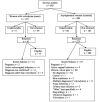Vulvodynia: characteristics and associations with comorbidities and quality of life
- PMID: 16507933
- PMCID: PMC1431685
- DOI: 10.1097/01.AOG.0000199951.26822.27
Vulvodynia: characteristics and associations with comorbidities and quality of life
Abstract
Objective: This case-control survey compared health history and health care use of women with vulvodynia with a control group reporting absence of gynecologic pain.
Methods: Women with a clinically assessed diagnosis of vulvodynia and asymptomatic controls were matched for age and mailed a confidential survey that evaluated demographics, health history, use of the health care system, and history of vulvodynia. Participants were all current or former ambulatory patients within a university health care system.
Results: Of the 512 questionnaires mailed to valid addresses, 70% (n = 91) of cases and 72% (n = 275) of controls responded, with 77 cases and 208 controls meeting eligibility criteria. Women with vulvodynia reported a substantial negative impact on quality of life, with 42% feeling out of control of their lives and 60% feeling out of control of their bodies. Forty-one percent indicated a severe impact on their sexual lives. When comorbidities were evaluated individually and adjusted for age, fibromyalgia (odds ratio 3.84, 95% confidence interval 1.54-9.55) and irritable bowel syndrome (odds ratio 3.11, 95% confidence interval 1.60-6.05) were significantly associated with vulvodynia. On a multivariate level, vulvodynia was correlated with a history of chronic yeast vaginitis and urinary tract infections.
Conclusion: This survey highlights the psychological distress associated with vulvodynia and underscores the need for prospective studies to investigate the relationship between chronic bladder and vaginal infections as etiologies for this condition. As well, the association of vulvodynia with other comorbid conditions, such as fibromyalgia and irritable bowel syndrome, needs to be further evaluated.
Level of evidence: II-2.
Figures

Similar articles
-
Assessment of vulvodynia symptoms in a sample of US women: a prevalence survey with a nested case control study.Am J Obstet Gynecol. 2007 Feb;196(2):128.e1-6. doi: 10.1016/j.ajog.2006.07.047. Am J Obstet Gynecol. 2007. PMID: 17306651 Free PMC article.
-
Relationship between vulvodynia and chronic comorbid pain conditions.Obstet Gynecol. 2012 Jul;120(1):145-51. doi: 10.1097/AOG.0b013e31825957cf. Obstet Gynecol. 2012. PMID: 22914403 Free PMC article.
-
Characteristics of the vaginal microbiome in women with and without clinically confirmed vulvodynia.Am J Obstet Gynecol. 2020 Sep;223(3):406.e1-406.e16. doi: 10.1016/j.ajog.2020.02.039. Epub 2020 Mar 2. Am J Obstet Gynecol. 2020. PMID: 32135142 Free PMC article.
-
Diagnosis and treatment of vulvodynia.Ann Med. 1995 Apr;27(2):175-81. doi: 10.3109/07853899509031955. Ann Med. 1995. PMID: 7632410 Review.
-
Vulvodynia--a complex syndrome of vulvar pain.Acta Obstet Gynecol Scand. 1995 Apr;74(4):243-7. doi: 10.3109/00016349509024442. Acta Obstet Gynecol Scand. 1995. PMID: 7732794 Review.
Cited by
-
Patterns in Vulvodynia Treatments and 6-Month Outcomes for Women Enrolled in the National Vulvodynia Registry-An Exploratory Prospective Study.J Sex Med. 2018 May;15(5):705-715. doi: 10.1016/j.jsxm.2018.03.003. Epub 2018 Apr 7. J Sex Med. 2018. PMID: 29631955 Free PMC article.
-
Efficacy of Internet-Based Guided Treatment for Genito-Pelvic Pain/Penetration Disorder: Rationale, Treatment Protocol, and Design of a Randomized Controlled Trial.Front Psychiatry. 2018 Jan 22;8:260. doi: 10.3389/fpsyt.2017.00260. eCollection 2017. Front Psychiatry. 2018. PMID: 29403395 Free PMC article.
-
Aggravating and protective factors in patients' experiences of vulvodynia: a qualitative study with Italian women.BMC Psychol. 2025 Mar 17;13(1):260. doi: 10.1186/s40359-024-02318-z. BMC Psychol. 2025. PMID: 40098064 Free PMC article.
-
Pain Rating in Women with Provoked Vestibulodynia: Evaluating Influence of Race.J Womens Health (Larchmt). 2016 Jan;25(1):57-62. doi: 10.1089/jwh.2015.5223. Epub 2015 Nov 18. J Womens Health (Larchmt). 2016. PMID: 26580986 Free PMC article. Clinical Trial.
-
Differences in pain subtypes between Hispanic and non-Hispanic white women with chronic vulvar pain.J Womens Health (Larchmt). 2015 Feb;24(2):144-50. doi: 10.1089/jwh.2014.4892. Epub 2015 Jan 20. J Womens Health (Larchmt). 2015. PMID: 25603224 Free PMC article.
References
-
- Moyal-Barracco M, Lynch PJ. 2003 ISSVD terminology and classification of vulvodynia: a historical perspective. J Reprod Med. 2004;49:772–7. - PubMed
-
- Harlow BL, Stewart EG. A population-based assessment of chronic unexplained vulvar pain: have we underestimated the prevalence of vulvodynia? J Am Med Womens Assoc. 2003;58:82–8. - PubMed
-
- Metts JF. Vulvodynia and vulvar vestibulitis: challenges in diagnosis and management. Am Fam Physician. 1999;59:1547–56. 1561-2. - PubMed
-
- Sadownik LA. Clinical profile of vulvodynia patients. A prospective study of 300 patients. J Reprod Med. 2000;45:679–84. - PubMed
-
- Friedrich EG., Jr Vulvar vestibulitis syndrome. J Reprod Med. 1987;32:110–4. - PubMed
Publication types
MeSH terms
Grants and funding
LinkOut - more resources
Full Text Sources
Other Literature Sources
Medical
Research Materials

